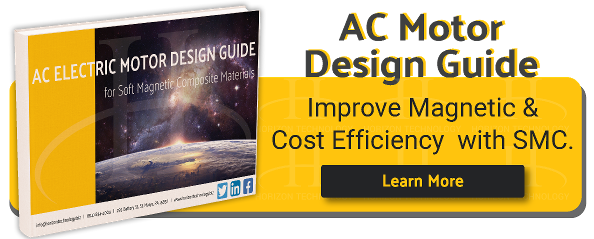Every engineer using rare-earth magnets (REMs) in their motor design has a problem today.
As Europe, Asia, and some American states impose more regulations on greenhouse gases, the demand for further “electrification” of automobiles continues to rise. Electrification is in turn causing a spike in demand for rare-earth materials. Magnets made from these materials perform admirably in AC electric motor designs for multiple reasons, but make the end product all that more expensive.
Because China controls more than 80% of the total marketplace for the mineral processing used to make these magnets, there are issues of both cost and availability. The COVID crisis only strained the supply chain further.
To nobody’s surprise, designers are seeking rare-earth motor magnet alternatives. And that’s where a secret weapon of powder metallurgy comes into play.
Soft magnetic composite materials can reduce dependency on rare-earth motor permanent magnets while maintaining competitive performance levels. This has far-reaching opportunities for customers who are open to designing with powder metallurgy’s green technology. We’ll explain how.
Which Rare-Earth Motor Magnets Can You Target With Alternatives?
Several rare-earth magnet materials are candidates for replacement or reduction.
These materials are part of the lanthanide (rare-earth) series on the periodic table of elements. Remember that lonely-looking block of the table that’s separated from the main section? The top line of that “separated” section represents the lanthanide series.
Neodymium
Why use this material? There’s no denying the magnetic properties of rare-earth metals. When you mix neodymium, iron, and boron in the right percentages, you create a magnet that has more powerful energy output (aka attractive power).
Imagine the refrigerator magnet that keeps your grocery list in place. Comparatively speaking, it has a pull force of, say, 1 … while a neodymium-infused magnet has a force of 100 or more. This creates more force and interaction in a motor.
Unfortunately, today’s iron-neodymium magnets are 2-3x the cost of what they used to be. Designers should strongly consider value alternatives where possible.

Praseodymium & Dysprosium
Why use these materials? Once the temperature goes above the Curie point, the magnet loses its performance. Praseodymium and dysprosium make the magnet more resistant to demagnetization over a greater temperature range.
This is a critical performance goal in AC electric vehicle design. Motors, of course, get hot over time.
These two rare-earth materials can boost the Curie point of a standard alloy by as much as 300° F.
Other Industrial-Strength Rare-Earth Magnet Materials
Other rare-earth materials, such as terbium and gadolinium, are fairly common in motor design. They serve a similar purpose to what you see above.
Automakers have even started replacing traditional rare-earth materials with slightly less-expensive rare-earth materials. In mass production, a little still adds up to a lot.
But what if we could get rid of them 100%?
How SMCs Reduce Reliance on Rare-Earth Motor Magnets
Soft magnetic composites (SMCs) are an emerging solution to reducing your reliance on pricey, hard-to-get materials.
The goal of SMCs here isn’t to magically change or improve upon the magnetic properties of rare earth-metals. Instead, SMCs unlock net-shaping capability that opens the door to different motor shapes and concepts, allowing you to forgo the use of REMs.
Instead of a standard radial motor design, forward-thinking engineers are looking at sleeker alternatives, like:
- Axial flux motors
- Transverse flux motors
- Switched reluctance motors
- Even redesigned radial flux motors!
They’re using non-rare-earth permanent magnets in those unique designs, but still achieving the same performance as a same-size radial motor.
Soft magnetic composite (SMC) materials can reduce dependency on rare-earth motor permanent magnets by substituting ferrite magnets via unique motor concepts in regard to the flux concentration design. These unique motor designs are often impractical with laminations, but easily obtainable via SMC technology. The end result is lower cost while maintaining competitive performance levels.
And you can certainly use rare-earth materials in a transverse or axial electric motor to get certain benefits -- it’s just no longer worth it. SMCs present too great a value proposition.
Implications of Reducing Rare-Earth Permanent Magnet Motors
SMCs allow you to use ferrite magnets, but change the shape of how they’re incorporated into the motor. And that electric motor will still be quite powerful.
This has implications for reducing rare-earth materials in nontraditional consumer applications. The energy industry can benefit too, as SMC can support the transition to cleaner technologies.
Meeting Tomorrow’s Standards
Words like “electrification” and “sustainability” aren’t going away. Leaving rare-earth metals behind for powder metallurgy’s advantages can push your AC electromagnetic design closer to meeting environmental standards -- while maintaining performance.
To learn more about the many other performance and cost implications of moving to an SMC-based design, see the visual resource below:




